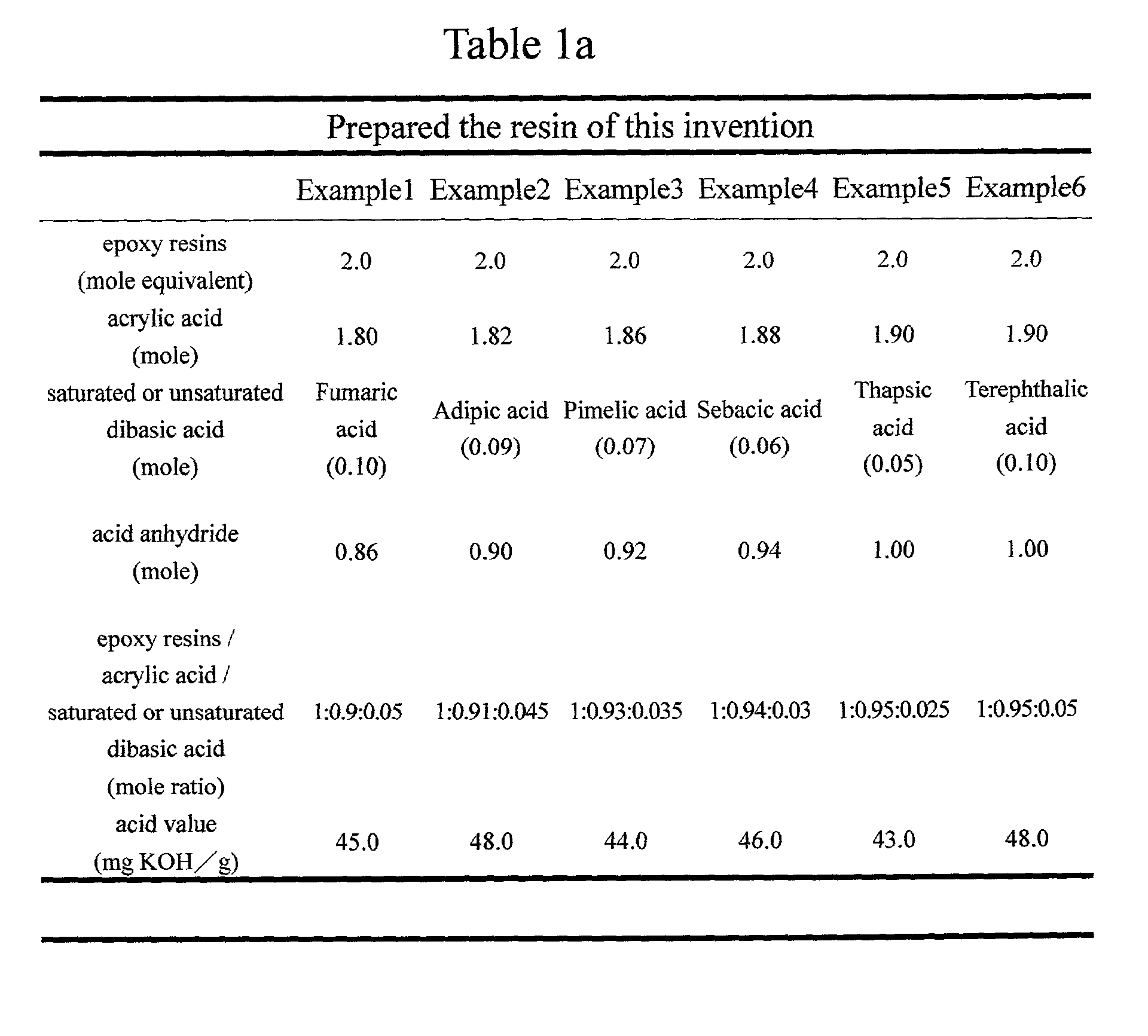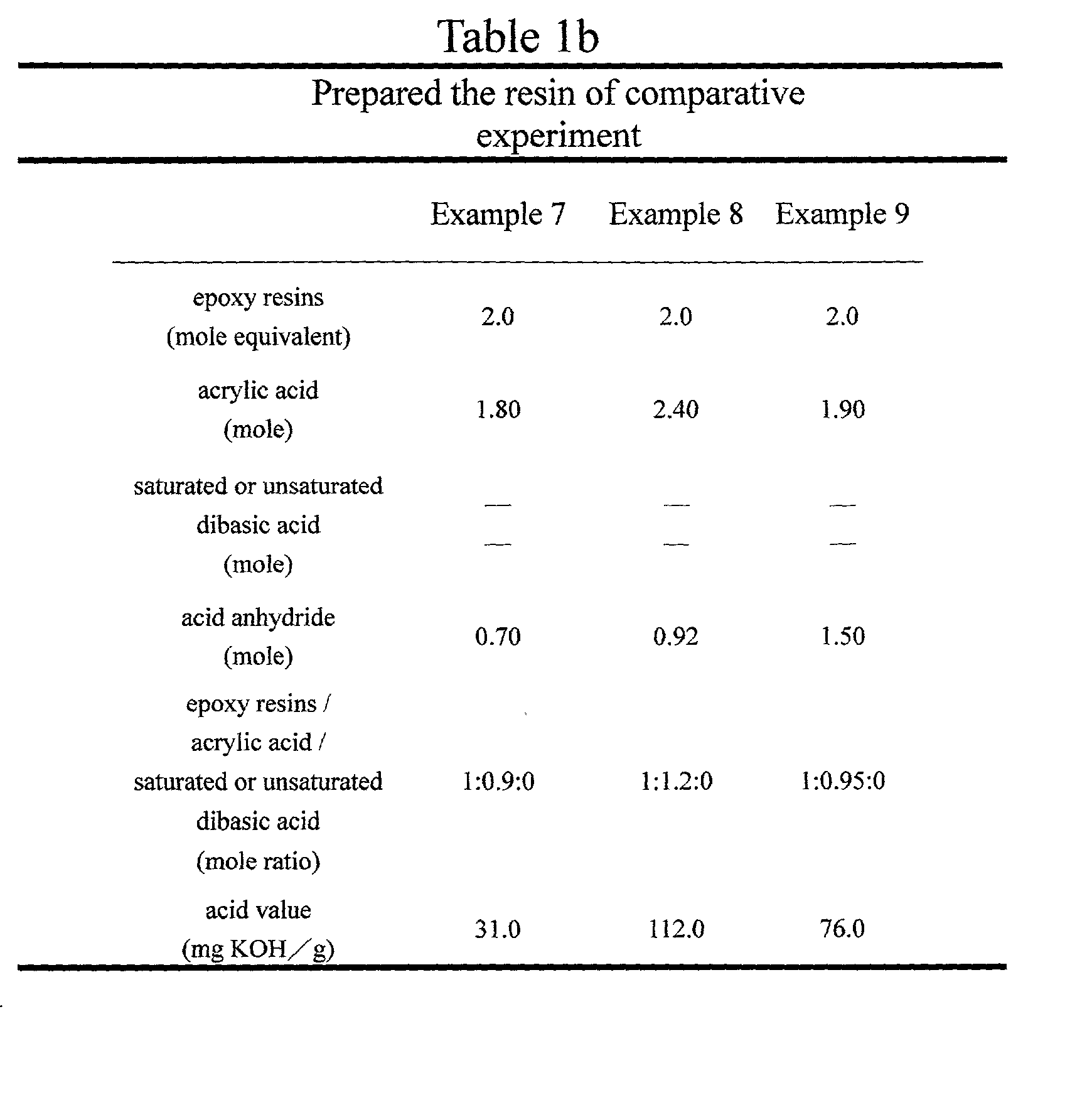Photothermosetting component
a technology of photothermosetting and components, applied in the direction of thermography, film/foil adhesives, non-metallic protective coating applications, etc., can solve the problems of affecting the qualification of solder masks, affecting the application, and affecting the application of qualification,
- Summary
- Abstract
- Description
- Claims
- Application Information
AI Technical Summary
Problems solved by technology
Method used
Image
Examples
example 2
[0041] This Invention
[0042] To a four-necked reaction vessel was added 220 g of carbitol acetate, 220 g of naphtha 150, then 396 g of epoxy cresol novolak resin ( soft point: 82.degree. C., epoxy equivalent weight (EEW): 198) was added at 90.degree. C.; a mixture was blended to be dissolved; then 0.40 g of hydroquinone, 131 g (1.82 mole) of acrylic acid, 13.14 g (0.09 mole) of adipic acid, and 2.5 g of triphenylphosphine were added. A mixture was heated at 110.degree. C. for 20 hours at least, then 136.8 g (0.90 mole) of tetrahydrophthalic anhydride anhydride was added. A reaction mixture was heated continually at 110.degree. C. for 8 hours. Acid value was determined as 48 mg KOH / g.
example 3
[0043] This Invention
[0044] To a four-necked reaction vessel was added 220 g of carbitol acetate, 220 g of naphtha 150, then 430 g of epoxy cresol novolak resin ( soft point: 80.degree. C., epoxy equivalent weight (EEW): 215) was added at 90.degree. C.; a mixture was blended to be dissolved; then 0.40 g of hydroquinone, 134 g (1.86 mole) of acrylic acid, 11.2 g (0.07 mole) of pimelic acid, and 2.5 g of triphenylphosphine were added. A mixture was heated at 110.degree. C. for 20 hours at least, then 139.8 g (0.92 mole) of tetrahydrophthalic anhydride anhydride was added. A reaction mixture was heated continually at 110.degree. C. for 8 hours. Acid value was determined as 44 mg KOH / g.
example 4
[0045] This Invention
[0046] To a four-necked reaction vessel was added 220 g of carbitol acetate, 220 g of naphtha 150, then 420 g of epoxy cresol novolak resin ( soft point: 81.degree. C., epoxy equivalent weight (EEW): 210) was added at 90.degree. C.; a mixture was blended to be dissolved; then 0.40 g of hydroquinone, 1350 g (1.88 mole) of acrylic acid, 12.12 g (0.06 mole) of sebacic acid, and 2.5 g of triphenylphosphine were added. A mixture was heated at 110.degree. C. for 20 hours at least, then 142.9 g (0.94 mole) of tetrahydrophthalic anhydride anhydride was added. A reaction mixture was heated continually at 110.degree. C. for 8 hours. Acid value was determined as 46 mg KOH / g.
PUM
| Property | Measurement | Unit |
|---|---|---|
| heat resistance | aaaaa | aaaaa |
| acid value | aaaaa | aaaaa |
| acid value | aaaaa | aaaaa |
Abstract
Description
Claims
Application Information
 Login to View More
Login to View More - R&D
- Intellectual Property
- Life Sciences
- Materials
- Tech Scout
- Unparalleled Data Quality
- Higher Quality Content
- 60% Fewer Hallucinations
Browse by: Latest US Patents, China's latest patents, Technical Efficacy Thesaurus, Application Domain, Technology Topic, Popular Technical Reports.
© 2025 PatSnap. All rights reserved.Legal|Privacy policy|Modern Slavery Act Transparency Statement|Sitemap|About US| Contact US: help@patsnap.com



